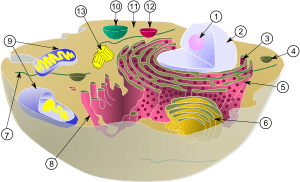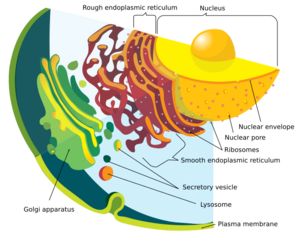Eukaryote facts for kids
Quick facts for kids Eukaryotes |
|
|---|---|
 |
|
| Eukaryote diversity | |
| Scientific classification | |
| Domain: |
Eukarya
|
| Kingdoms | |
|
Alternatively:
|
|
A eukaryote is a living thing made of cells that are complex. Or, it can be a single cell with a complex structure. In these cells, the genetic material is organized into chromosomes. These chromosomes are found inside a special part of the cell called the cell nucleus.
Many living things you know are eukaryotes. This includes animals, plants, algae, and fungi. Some tiny, single-celled organisms called protists are also eukaryotes. Simpler living things, like bacteria and archaea, are different. They do not have a nucleus or other complex cell parts. These simpler organisms are called prokaryotes.
Scientists often group all eukaryotes together as a "domain" or "superkingdom."
Eukaryotes first appeared a very long time ago. This was during the Proterozoic eon. The oldest known eukaryote might be Grypania. This was a long, coiled filament up to 30mm long. The oldest Grypania fossils were found in Michigan. They are about 1874 million years old.
Another old group is the acritarchs. Scientists think these were tiny cysts or reproductive parts of algal plankton. They have been found in fossils from 1400 million years ago.
Scientists are still discussing how to classify eukaryotes. Many different ways of grouping them have been suggested. Most modern ideas have five main groups, called kingdoms. But they don't always agree on which smaller groups belong in each kingdom.
Contents
What's Inside Eukaryotic Cells?
Eukaryotic cells are usually much bigger than prokaryotic cells. They can be up to 10 times larger. Eukaryote cells have many different parts inside them. These parts are called organelles. Each organelle has a special job.
Eukaryotic cells also have a cytoskeleton. This is like a cell's skeleton. It is made of tiny tubes and fibers. The cytoskeleton helps the cell keep its shape. It also helps the cell move things around inside.
The DNA in eukaryotic cells is bundled into chromosomes. These chromosomes are found in the nucleus. When a eukaryotic cell divides, the chromosomes are carefully separated. Most eukaryotes can have sexual reproduction. This means two cells combine their genetic material. Prokaryotes do not reproduce this way.
Prokaryotes do not have sexes. But they can still share DNA with other bacteria. Their cell division is asexual. This means one cell simply splits into two. Sometimes, bacteria can pass DNA to each other by touching. This is called Bacterial conjugation.
Eukaryotes have sets of linear chromosomes. These are located in the nucleus. The number of chromosomes is usually the same for all individuals of a species.
Internal Membranes
Eukaryotic cells have many parts surrounded by membranes. All these parts together are called the endomembrane system. Small, simple sacs called vesicles or vacuoles can form. They bud off from other membranes, like bubbles.
Many cells take in food or other things using a process called endocytosis. In endocytosis, the outer membrane of the cell bends inward. Then, it pinches off to form a vesicle inside the cell. Many other organelles with membranes likely started as vesicles.
The nucleus is surrounded by a double membrane. This is called the nuclear envelope. It has small holes called nuclear pores. These pores let things move in and out of the nucleus.
The nuclear envelope has parts that stick out. These look like tubes and sheets. They are called the endoplasmic reticulum, or ER. The ER helps move proteins around. It also helps proteins become their final shape.
The ER has two main parts: the rough ER and the smooth ER. The rough ER has tiny dots called ribosomes attached to it. Proteins made by these ribosomes go inside the rough ER. This inner space is called the lumen. After that, these proteins usually move into vesicles. These vesicles grow and pinch off from the smooth ER.
In most eukaryotes, these protein-filled vesicles then join with stacks of flattened sacs. These stacks are called the Golgi bodies. Inside the Golgi bodies, the proteins are changed again.
Vesicles can become specialized. This means they change to do one specific job very well. This is called differentiation. For example, lysosomes are vesicles that contain special enzymes. These enzymes break down food that comes from food vacuoles. Peroxisomes are another example. They have enzymes that break down peroxide, which is a poisonous substance.
Many tiny organisms called protozoa have contractile vacuoles. These vacuoles can take in or get rid of extra water. Extrusomes are special vesicles that shoot out substances. These substances can scare away predators or help catch food. In complex plants, most of the cell's inside is filled by a large central vacuole. This central vacuole helps keep the cell's shape. It does this by controlling osmotic pressure.
How Eukaryotes Began
The different organelles inside eukaryotes have different origins. It seems that most of these organelles came from once-independent prokaryotes. These prokaryotes were either bacteria or archaea. It's like the eukaryote cell is a "community of micro-organisms" working together. This idea is called the endosymbiotic theory.
The first steps of this process happened when ancient bacteria combined. This led to a type of bacteria with two membranes. These include cyanobacteria. This was just the first of many such events in the history of eukaryotes.
Classification
The group called Protista includes many different single-celled organisms. Scientists have suggested more precise ways to classify them. But they are still debating these ideas. So, "Protista" is still a useful term for these organisms.
Here is one modern way to classify the Eukarya:
| Opisthokonts | This group includes animals, fungi, and tiny organisms called choanoflagellates. |
| Amoebozoa | This group has most amoeboids that move with blunt "feet," and slime moulds. |
| Rhizaria | This group includes Foraminifera, Radiolaria, and other amoeboid protozoa. |
| Excavates | This group contains various flagellate protozoa (which have whip-like tails). |
| Archaeplastida (or Primoplantae) | This group includes land plants, green algae, red algae, and glaucophytes. |
| Chromalveolates | This group includes Heterokonts, Haptophytes, Cryptomonads, and Alveolates. |
However, some scientists have questioned if some of these groups are truly "monophyletic." This means they wonder if all members of the group came from a single common ancestor. This is especially true for the Chromalveolata.
The Eukarya might be unified because their cells are a community. This community formed from bacteria and archaea. But scientists have different opinions on this. Like the Protista, the Eukarya might be a group of organisms that came from different ancestors.
However, all branches of the Eukarya have sexual reproduction. Also, they all have a similar organization of their nucleus. These two points are the main evidence that eukaryotes came from a single common ancestor.
Images for kids
-
One hypothesis of eukaryotic relationships – the Opisthokonta group includes both animals (Metazoa) and fungi, plants (Plantae) are placed in Archaeplastida.
-
Phylogenetic tree showing a possible relationship between the eukaryotes and other forms of life; eukaryotes are colored red, archaea green and bacteria blue
See also
 In Spanish: Eukaryota para niños
In Spanish: Eukaryota para niños











